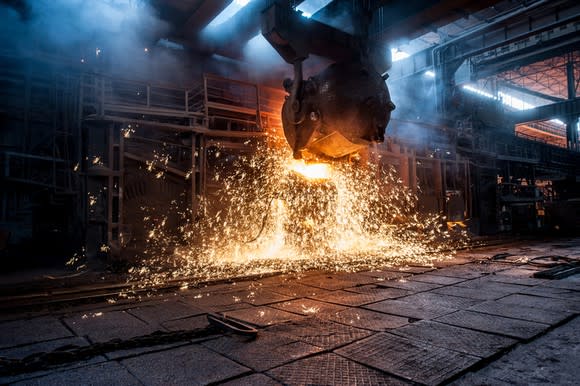Don't Get Greedy With United States Steel Corporation Stock
The American steel industry was abuzz with tariff talk throughout the month of March. After months of speculation that the United States would take a firmer stance on steel and aluminum trade, the Trump administration handed down steep tariffs on foreign supplies. The news initially sent shares of leading domestic steel producers like Nucor and United States Steel Corporation (NYSE: X) soaring.
But the euphoria didn't last long. Shares of both Nucor and United States Steel gave back all of their trade-related gains before the end of March and are now down 13% and 25%, respectively, since the announcement. While the up-and-down month proved that tariffs alone are not a solid foundation for an investing thesis in the industry, that's especially true when considering United States Steel Corporation stock.

Image source: Getty Images.
By the numbers
United States Steel turned in a strong year of operations in 2017. In fact, it was the most profitable annual period since 2014 on the basis of segment operating profits. The last time net income matched last year's level was 2009. It was all made possible by years of restructuring and difficult decisions that are finally paying off.
Metric | 2017 | 2016 | Change (YOY) |
|---|---|---|---|
Revenue | $12.2 billion | $10.3 billion | 18.4% |
Reportable segment EBIT | $608 million | ($122 million) | N/A |
Net income | $387 million | ($440 million) | N/A |
Diluted earnings per share | $2.19 | ($2.81) | N/A |
Data source: SEC filings. YOY = year over year. EBIT = earnings before interest and income taxes.
The performance delivered by quickly improving operations explains why Wall Street was giddy with excitement when it was announced that some form of tariffs (and possibly even quotas) would indeed be enforced. That's because tariffs would impose steep premiums on imported steel, while quotas would reduce the amount of steel legally allowed to be imported. Both actions would hand domestic producers market share virtually overnight -- if they were enacted.
So why did Mr. Market decide to rescind his gift of a higher share price? Well, despite the Trump administration announcing major tariffs on steel and aluminum from basically any foreign source, things aren't so simple in practice. Certain grades of steel aren't manufactured in the United States. That includes strategically important materials, such as those used to build pipelines needed to transport the country's surging levels of oil and natural gas.
Therefore, it was inevitable that the tariffs would come with quite a few exceptions as dozens of countries and industries lined up to ask for exemptions. It didn't take long for such a situation to materialize, and once Wall Street saw the writing on the wall, it decided United States Steel may not receive much -- if any -- boost from revamped trade policy.
Then again, even if tariffs did have teeth, the company's history of fumbling away market opportunities shouldn't be overlooked by investors.

Image source: Getty Images.
For example, despite an abundance of warning signs, United States Steel purchased Canadian steel manufacturer Stelco in 2007 for $1.1 billion when steel prices hit an all-time high. It ended up being sold about a decade later for just $124 million. As The Motley Fool's Tyler Crowe has noted, the acquisition is a shining example of the company's long history of poor capital allocation and downright awful timing.
That history should also make investors wonder if any potential opportunities created by tariffs wouldn't be wasted away in a similar fashion. It may not matter much in the near-term, anyway, as trade issues won't result in a more favorable market for United States Steel in 2018.
That means investors will have to rely on operational improvements to carry the stock. At the moment, there's no denying that the stock is among the most expensive among its steel and aluminum peers. Can it grow into its premium valuation? Perhaps. The good news is management has guided for full-year 2018 net income of $685 million and diluted EPS of $3.88.
The bad news is investors have been here before. Seemingly every time the industry cycle peaks and the business begins to improve, United States Steel turns too aggressive and ends up paying for its mistakes later. Management also admitted the numbers in its full-year 2018 guidance are subject to change based on market conditions and that initial guidance was solely based on selling prices from the end of January. But given the high degree of uncertainty regarding international trade at the moment, it would be best for investors to remain grounded.

Image source: Getty Images.
Don't get greedy with this steel stock
By now most market analysts have realized that potential tariffs on imported steel are unlikely to have any substantial near-term impact on the operations of American steel companies. Shares of United States Steel have performed among the worst in the industry since Mr. Market came to that realization, in large part because of the business' industry-lagging metrics and multiples. Simply put, investors shouldn't get greedy with United States Steel Corporation.
More From The Motley Fool
Maxx Chatsko has no position in any of the stocks mentioned. The Motley Fool recommends Nucor. The Motley Fool has a disclosure policy.
